 |
Blue-eyed Mary, Collinsia
parviflora
Douglas ex Lindl. (left and
right). Blue-eyed Mary flowers are no more than 1/8 inch long, appearing
as tiny blue dots underfoot soon after the snow melts. With magnification,
you’ll see that the flowers are attractive, with a lower lip made up
of two turned-down, blue-tipped white petals. An unclassified form (right),
photographed on the Clearwater River ,with flowers 1/2 inch long, grows in
north-central Idaho. It seems to occupy a niche midway between the common
blue-eyed Mary (left) and an even larger species with flowers to 3/4 inch
long, Collinsia grandiflora Lindl., that
grows in the Columbia Gorge, a plant that Lewis and Clark collected on April
17, 1806, early on their return journey. |
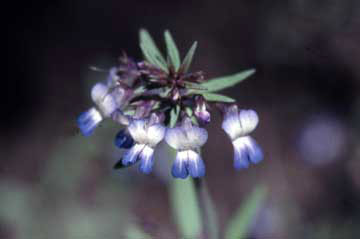 |
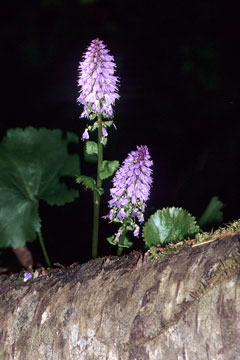 |
Mountain kittentoes, Synthyris
missurica (Raf.) Pennel (left),
shaded, moist woods. The tiny four-petaled flowers are so similar to veronicas
that at one time the plant was in that genus; with ongoing study it may find
itself a Veronica again . The small leafy bracts below the flower
cluster help to identify this and several related species, as do its broad,
scalloped basal leaves. The plant shown here was photographed in deep woods
along US Highway 12 adjacent to the Clearwater River, close to where Meriwether
Lewis collected the plant on the expedition’s return journey (June 26,
1806).
American brooklime, Veronica
americana Schwein. ex Benth.
(right). Veronica flowers are irregular. The upper petal is large while the
remaining three are distinctly smaller in size. While veronicas in general
prefer moist places, some, like the American brooklime, are water plants
that grow along the edges of small streams with their roots submerged. It
is identified by its growth preference, by ovoid, finely serrated leaves
and by its small, slightly irregular, blue flowers. The word "brooklime"
was derived from an Old English word. |
 |
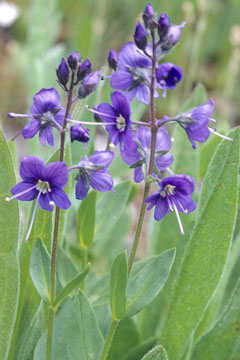 |
Cusick’s speedwell, Veronica cusickii
A. Gray (left) is a subalpine plant. Its small
flowers are deep blue to violet, borne in a loose terminal cluster,
or “raceme.” It may be identified by its long, yellow-tipped stamens,
and even longer stigmas. William Conklin Cusick (1842-1922) for whom this
plant is named taught and ranched in Oregon. He found this namesake plant
in the Blue Mountains of Oregon. It was described in 1878 by Harvard’s
professor of botany, Asa Gray.The name “speedwell" is a testimonial
to the plant’s perceived medicinal value.
American alpine speedwell, Veronica
wormskjoldii Roem. & J. A.
Schultes (right) is an attractive, small, subalpine flower.
Its stem is hairy and its flower lack the long anthers and stigmas of
Cusick’s speedwell (left). Morten Wormskjold (1783-1845) was a Danish
botanist who, in 1813, led an expedition to Greenland where he collected
this plant. |
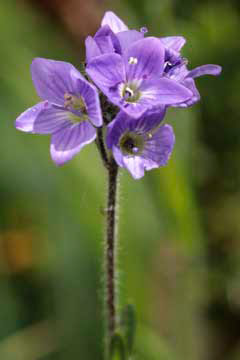 |
 |
Butter-and-egg plant, Linaria
vulgaris Hill (left) and Dalmatian toadflax,
Linaria dalmatica (L.) Mill. (right). This common plant's clustered
butter-yellow and egg-yolk-orange flowers immediately identify it. It and
the Dalmatian toadflax, Linaria dalmatica were introduced from Europe
as ornamentals during the 1800s and now grow in Idaho as high as the subalpine
zone, often forming dense patches that crowd out other plants. Both species
are ranked as serious weeds. The Dalmatian toadflax has a looser flower cluster,
smaller flowers, the flowers’ basal spurs are sharper, the leaves are
wider and they clasp the stem—a consistent identifying feature. Toadflaxes
in general have three-petaled upper and two petaled lower “lips”
that meet to resemble a toad’s mouth. This and flax-like leaves explain
the name “toadflax.” Linaria was derived from the scientific
name for flax, Linum. |
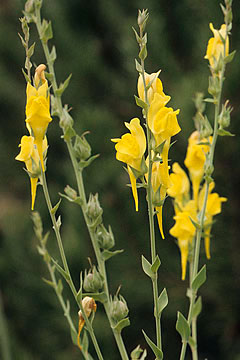 |
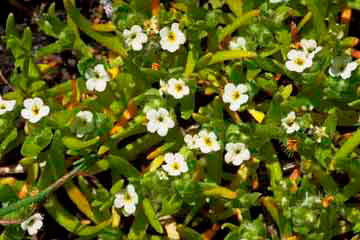 |
Owyhee mudwort, Limosella
acaulis Sellé & Mocino (left) has
tiny flowers, less than 1/8" across. They are almost symmetrical with only
a hint of the lip common to most Scrophulariaceae. Its name,
Limosella, from the Latin, implies "stagnant (or muddy) water."
The spring- and summer blooming plants form short-lived mats
on muddy ground. The related Limosella aquatica L.
(not shown) is widely distributed in North America and Eurasia,
but our plant is found only in the American West (Idaho, Oregon, California,
Nevada, Arizona and New Mexico). We have seen it growing in
Blaine County (Dollar Mountain) and in Custer County (Bruce Meadows).
|
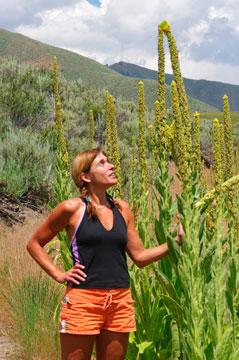 |
Common mullein, Verbascum
thapsus L. (left, right)
Because of the taxonomic changes noted in the introduction to this family,
the common mullein, Verbascum thapsus is the only true Scrophulariaceae
shown on these pages. The plant—a serious weed—has spread far and
wide since it was introduced from Eurasia. It thrives on dry disturbed ground,
and is increasingly found in our mountains well away from settled places.
Large dusty-green leaves, long stems, and dense clusters of irregular, yellow,
five-petaled flowers make the common mullein recognizable immediately. The
plants are biennial, forming small furry-leaved rosettes the first year,
and the familiar long-stalked plants the next; the latter can grow to be
8 feet or more in height (left). The stalked plants are difficult to
eradicate. Hydra-like, even when cut off close to the ground, the plants
respond by sending up a multitude of new, short fruiting stalks.
Verbascum is an ancient name for common mulleins; the word
mullein is from the Latin mollis, meaning “soft,” for the
velvety leaves, and Thapsus is the name of a city in Sicily.
|
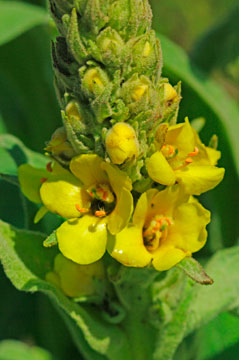 |










